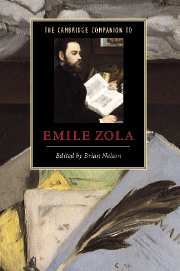Book contents
- Frontmatter
- 1 Zola and the nineteenth century
- 2 Family histories and family plots
- 3 Zola and the representation of society
- 4 Questions of sexuality and gender
- 5 Zola and contemporary painting
- 6 Zola and the art of fiction
- 7 Thérèse Raquin: animal passion and the brutality of reading
- 8 Nana: the world, the flesh and the devil
- 9 Germinal: the gathering storm
- 10 La Bête humaine: Zola and the poetics of the unconscious
- 11 Zola’s utopias
- 12 ‘J’accuse...!’: Zola and the Dreyfus Affair
- Further reading
- Index
9 - Germinal: the gathering storm
Published online by Cambridge University Press: 28 May 2007
- Frontmatter
- 1 Zola and the nineteenth century
- 2 Family histories and family plots
- 3 Zola and the representation of society
- 4 Questions of sexuality and gender
- 5 Zola and contemporary painting
- 6 Zola and the art of fiction
- 7 Thérèse Raquin: animal passion and the brutality of reading
- 8 Nana: the world, the flesh and the devil
- 9 Germinal: the gathering storm
- 10 La Bête humaine: Zola and the poetics of the unconscious
- 11 Zola’s utopias
- 12 ‘J’accuse...!’: Zola and the Dreyfus Affair
- Further reading
- Index
Summary
Ever alert to the differences between Balzac and himself as a measure of his own originality, the young Zola wrote in an article in Le Rappel (13 May 1870) that there is no place for the people in Balzac's works, but, he added, the reader can hear in the distance 'the great absent voice . . . the muted surge of the people ready to burst forth into political life, into sovereignty' ['la voix du grand absent . . . la sourde poussée du peuple qui va jaillir à la vie politique, à la souveraineté']. To some degree L'Assommoir filled the gap, but the novel of Gervaise Macquart's fate contains no hint of the political aspirations and potential of the working classes. By the early 1880s, however, Zola had included in his plan for the Rougon-Macquart series a second novel about the people, which would deal directly with the political activities of Parisian workers and culminate in the Commune. But, in the developing political climate of the early years of the Third Republic and as the Commune faded into history, the workers' movement came to be a more relevant form of social protest than insurrection and the strike a more topical means of revolt than the barricade. By early 1884, as Edmond de Goncourt noted in his Journal (16 January), Zola was thinking of writing a novel about a strike in a mining district and with it a 'profound study of the social question'. The Commune would have to wait until LaDébâcle (1892), where it is presented as a sequel to the depiction of the Battle of Sedan and the fall of the Second Empire.
- Type
- Chapter
- Information
- The Cambridge Companion to Zola , pp. 137 - 151Publisher: Cambridge University PressPrint publication year: 2007

